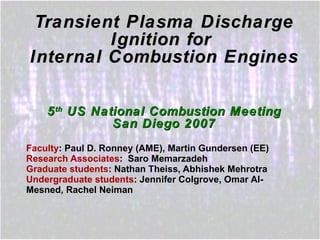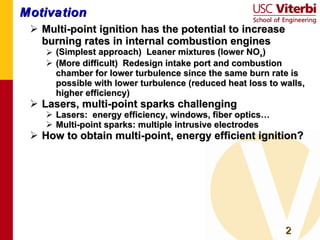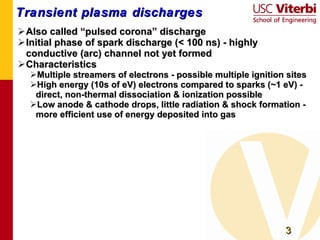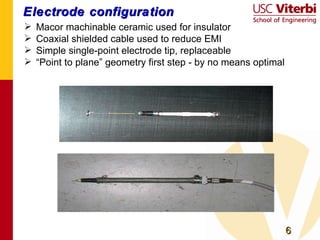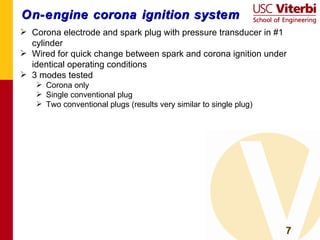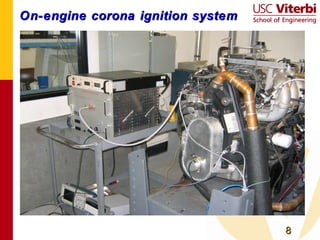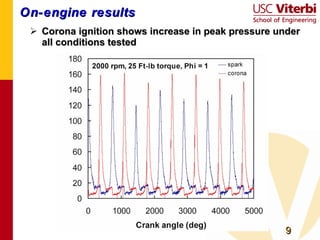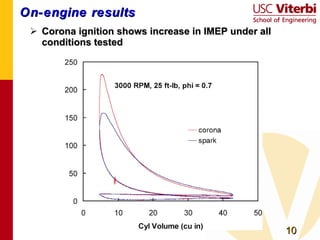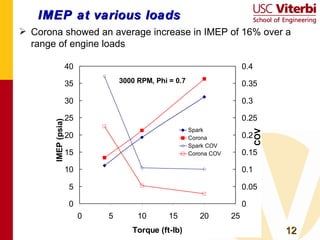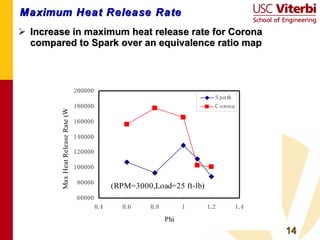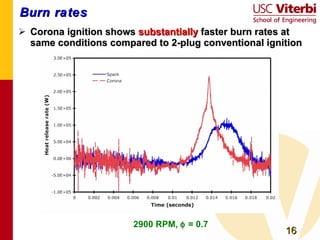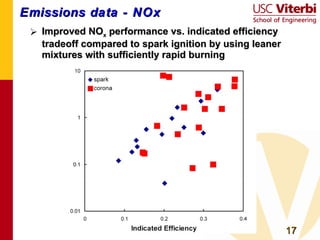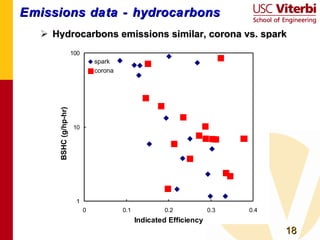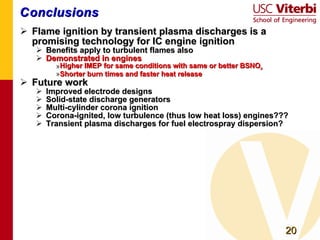Corona.engines.san diego.2007
- 1. Transient Plasma Discharge Ignition for Internal Combustion Engines 5 th US National Combustion Meeting San Diego 2007 Faculty : Paul D. Ronney (AME), Martin Gundersen (EE) Research Associates : Saro Memarzadeh Graduate students : Nathan Theiss, Abhishek Mehrotra Undergraduate students : Jennifer Colgrove, Omar Al-Mesned, Rachel Neiman
- 2. Motivation Multi-point ignition has the potential to increase burning rates in internal combustion engines (Simplest approach) Leaner mixtures (lower NO x ) (More difficult) Redesign intake port and combustion chamber for lower turbulence since the same burn rate is possible with lower turbulence (reduced heat loss to walls, higher efficiency) Lasers, multi-point sparks challenging Lasers: energy efficiency, windows, fiber optics… Multi-point sparks: multiple intrusive electrodes How to obtain multi-point, energy efficient ignition?
- 3. Transient plasma discharges Also called “pulsed corona” discharge Initial phase of spark discharge (< 100 ns) - highly conductive (arc) channel not yet formed Characteristics Multiple streamers of electrons - possible multiple ignition sites High energy (10s of eV) electrons compared to sparks (~1 eV) - direct, non-thermal dissociation & ionization possible Low anode & cathode drops, little radiation & shock formation - more efficient use of energy deposited into gas
- 4. Corona vs. arc discharge Corona phase (0 - 100 ns) Arc phase (> 100 ns)
- 5. Engine experiments 2000 Ford Ranger I-4 engine with dual-plug head to test corona & spark at same time, same operating conditions National Instruments / Labview data acquisition & control Horiba emissions bench, samples extracted from corona - equipped cylinder Pressure / volume measurements Optical Encoder mounted to crankshaft Spark plug mounted Kistler piezoelectric pressure transducer
- 6. Electrode configuration Macor machinable ceramic used for insulator Coaxial shielded cable used to reduce EMI Simple single-point electrode tip, replaceable “ Point to plane” geometry first step - by no means optimal
- 7. On-engine corona ignition system Corona electrode and spark plug with pressure transducer in #1 cylinder Wired for quick change between spark and corona ignition under identical operating conditions 3 modes tested Corona only Single conventional plug Two conventional plugs (results very similar to single plug)
- 8. On-engine corona ignition system
- 9. On-engine results Corona ignition shows increase in peak pressure under all conditions tested
- 10. On-engine results Corona ignition shows increase in IMEP under all conditions tested
- 11. IMEP at various air / fuel ratios Indicated mean effective pressure (IMEP) higher for corona than spark, especially for lean mixtures (nearly 30%) Coefficient of variance (COV) comparable
- 12. IMEP at various loads Corona showed an average increase in IMEP of 16% over a range of engine loads
- 13. Heat Release Time Decrease in heat release time for Corona compared to Spark over an equivalence ratio map
- 14. Maximum Heat Release Rate Increase in maximum heat release rate for Corona compared to Spark over an equivalence ratio map
- 15. Burn rate Integrated heat release shows faster burning with corona leads to greater effective heat release 2900 RPM, = 0.7
- 16. Burn rates Corona ignition shows substantially faster burn rates at same conditions compared to 2-plug conventional ignition 2900 RPM, = 0.7
- 17. Emissions data - NOx Improved NO x performance vs. indicated efficiency tradeoff compared to spark ignition by using leaner mixtures with sufficiently rapid burning
- 18. Emissions data - hydrocarbons Hydrocarbons emissions similar, corona vs. spark
- 19. Emissions data - CO CO emissions similar, corona vs. spark
- 20. Conclusions Flame ignition by transient plasma discharges is a promising technology for IC engine ignition Benefits apply to turbulent flames also Demonstrated in engines Higher IMEP for same conditions with same or better BSNO x Shorter burn times and faster heat release Future work Improved electrode designs Solid-state discharge generators Multi-cylinder corona ignition Corona-ignited, low turbulence (thus low heat loss) engines??? Transient plasma discharges for fuel electrospray dispersion?
Editor's Notes
- 2 Flame spread over solid fuels is a useful model for simple 2 phase spreading flames, like building fires. It has well defined properties which can easily be quantified, like the spread rate which relates to CO production. And it is highly dependant on the fuel and environment. Downward, opposed flow flame spread at 1g is generally well understood. However, opposed flow flame spread at microgravity is less understood but important in manned spacecraft. upward, concurrent flow flame spread, which is especially important in a building fire, is also less understood.
- 2 Flame spread over solid fuels is a useful model for simple 2 phase spreading flames, like building fires. It has well defined properties which can easily be quantified, like the spread rate which relates to CO production. And it is highly dependant on the fuel and environment. Downward, opposed flow flame spread at 1g is generally well understood. However, opposed flow flame spread at microgravity is less understood but important in manned spacecraft. upward, concurrent flow flame spread, which is especially important in a building fire, is also less understood.
- 2 Flame spread over solid fuels is a useful model for simple 2 phase spreading flames, like building fires. It has well defined properties which can easily be quantified, like the spread rate which relates to CO production. And it is highly dependant on the fuel and environment. Downward, opposed flow flame spread at 1g is generally well understood. However, opposed flow flame spread at microgravity is less understood but important in manned spacecraft. upward, concurrent flow flame spread, which is especially important in a building fire, is also less understood.
